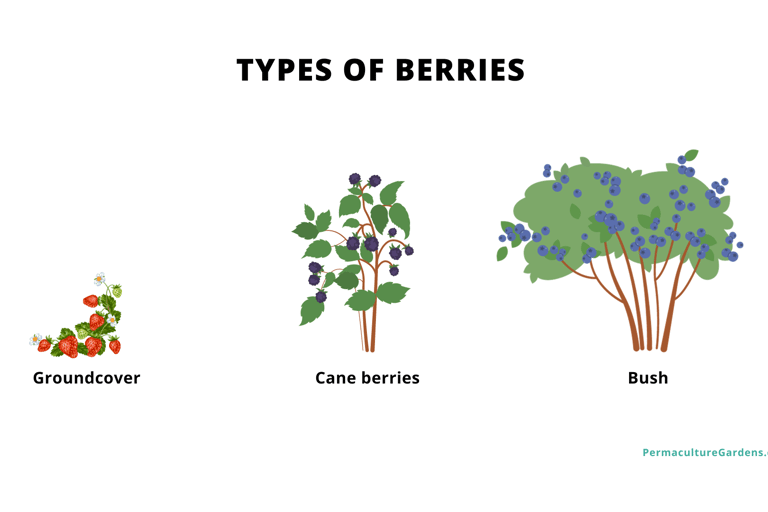Choosing the Right Berries for Your Perennial Garden
Berries are one of the easiest ways to get perennial harvests that come back year after year. Learn how to choose which berries to grow in your garden.
10/9/202323 min read
Choosing the Right Berries for your Perennial Garden
Disclaimer
This How to Choose Which Berries to Grow in Your Perennial Garden article may contain some affiliate links. The small commission we receive if you choose to purchase goes towards making this gardening education available for free! We do not affiliate for anything we do not personally use. Thanks so much for your support!

How to Choose the Right Berry
Not all berries will grow well in your garden
We hope this blog helps you choose the best berries for you and explains why these particular berries are excellent choices for getting perennial harvests in your backyard.
We will explore:
Berries to Consider Growing
Note on etymology: The term berry as used in this blog is defined at the end of this article.
1. Reasons to Grow Berries
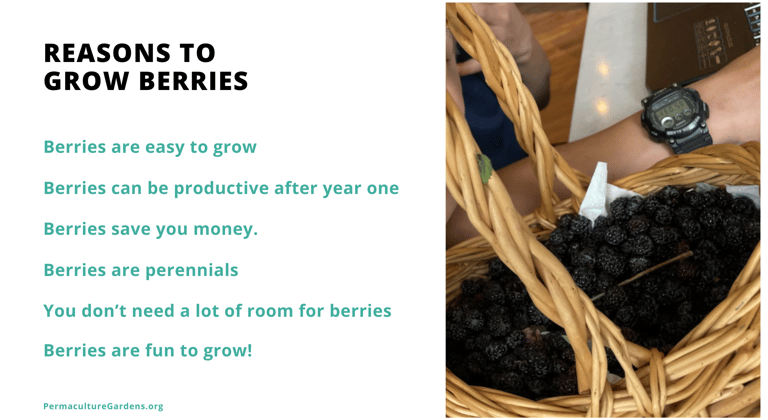

Berries are easy to grow
There are many advantages to growing berries as a herbaceous layer in our suburban and urban gardens.
First, berries are naturally adapted to grow vigorously in the wild, so we don’t have to coddle them like we do with so many of our annual plants to get great growth. Berries are easy to grow, once you get them established.
Unlike fruit-bearing trees, berries will often start producing in the first year after planting so we’ll be immediately motivated by the yields we get to encourage us in our garden-to-table quests. A berry's first year of production will never be as much as that of its third year. This is the point when its roots have taken a good hold in the ground and the plant is well-established. So don't expect a lot of harvest in year one.
Berries can be productive after one year
Finally, organic berries command a king’s ransom at the supermarkets, sometimes going for upwards of $7-$20/lb. Berries are a good high-value crop to use in our limited growing space.
Berries save you money. Lots of money.
More Advantages to Growing Berries
Berries are perennials. The benefits of planting perennials means you don't have to plant them again. See here for more perennial benefits.
Because berries are a high-value ($7-$20/lb) crop, they can potentially serve as a “cash crop” and even a source of income. Some varieties like seaberries and goumi are not available fresh commercially.
Berries do not need a lot of room to grow. They are space-saving!
Grow berries for the joy of growing and enjoying these delicacies!
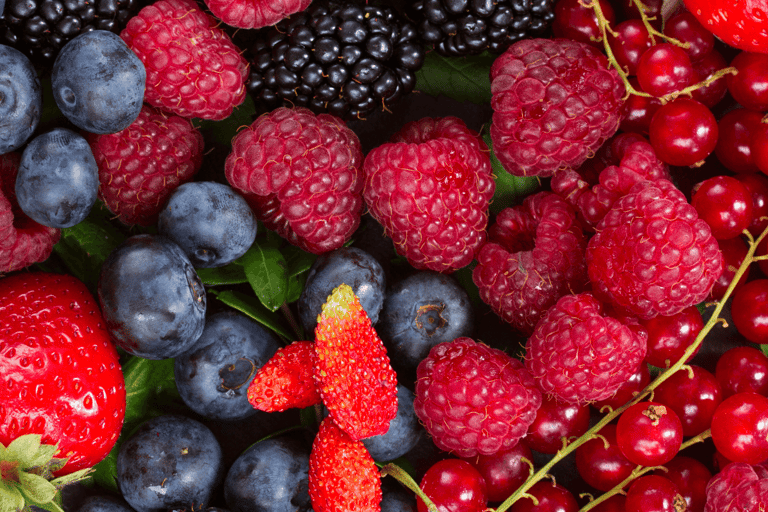

Types of Berries
Berries According to Growth Habit
We can categorize berries according to their growing habits. Organizing them in this way, also simplifies the way we care for and harvest our berries.
2. Berries to Consider Growing
Groundcover Berries
Ground cover berries like strawberries, cranberries, and lowbush blueberries are plants that don’t grow more than a foot in height, but gradually fill up spaces by spreading through stolons (runners). These berries have fairly shallow roots.
Cane Berries
Brambles or "cane" berries like raspberries and blackberries have a perennial root system that shoots up long fruiting branches each year. The first canes, called, "primocanes" are usually vegetative only. Berries are more often produced on second-year-old canes called "floricanes" but then stop being productive after that.
Note: Nowadays, there is a lot more research on breeding raspberry and blackberry cultivars that produce their first fruits on the tips of the primocane. This research is driven by the ability to "double crop" or harvest these berries twice in a year, instead of just during one season. Double-cropping lengthens your harvest season and increases your berry yield.
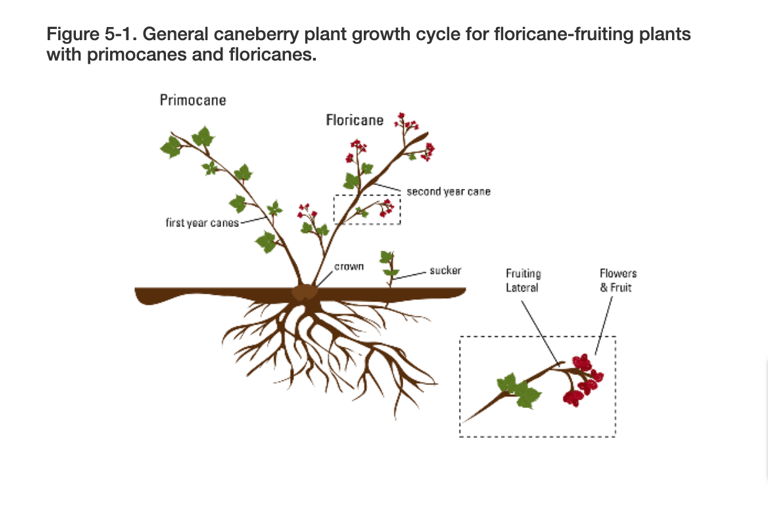

Bush Berries
Berry shrubs like gooseberry, goumi, and seaberry are like mini fruit trees, possessing all the growth characteristics of larger fruit trees but only growing 6-10 feet in height.
Image courtesy of North Carolina State Extension
Types of Berries
Strawberry (Fragaria × ananassa)
Strawberries are by far the most popular berry fruit in the world, largely because of their ease of cultivation.
According to Purdue University, "A planting originating from 25 plants can yield 25 to 50 quarts of berries ripening from mid-May to late June, depending upon the area of the state in which they are grown."
Each strawberry plant lives for about three years. However, in its lifetime a strawberry plant sends out runners that can be snipped off and replanted. (The strawberry will do the replanting if you don’t), so will constantly renew themselves by creating new plants.

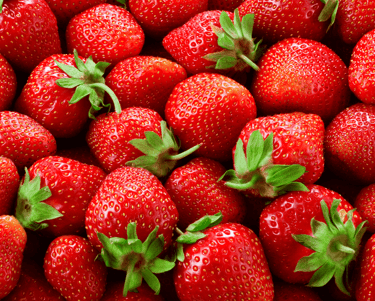
While Purdue University's Guide on Growing Strawberries recommends spacing them 2-3 feet apart, we know from experience that you can plant at least 25 crowns in a standard 4’x4′ raised bed, growing alongside other plants in a guild. You can then "thin" your strawberries later in the season by cutting any runner plants.
Strawberries can be planted densely
Which strawberry variety to choose
There are three main varieties, Day-neutral, Everbearing, and June-bearing types.
Day-neutral - strawberries that fruit several times per season. Usually not suitable for warmer climates.
Everbearing types will start bearing around late May and continue producing small amounts of strawberries continuously throughout the year.
June-bearing ones only produce a single crop, but the crop is larger and the strawberries tend to be a large size (this is good if you want to make strawberry jam).
There are also wild, alpine varieties that produce extremely small, but tasty strawberries.
Types of Strawberries
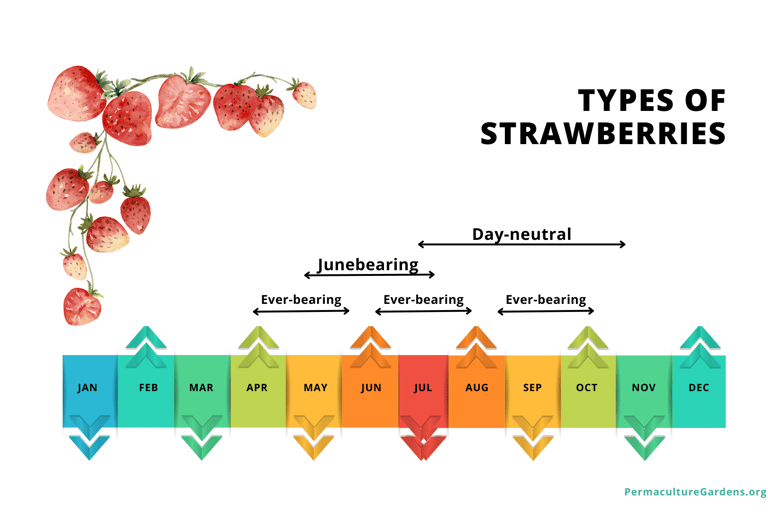

Strawberry types & their harvest times
Many of the modern strawberry varieties in the US are developed or studied by:
The University of California - Davis (Mediterranean climates, drought-tolerant)
Oregon State University (cooler-climate varieties), and the
University of Florida (Heat-tolerant, subtropical varieties).
Click on these links to learn about varieties suitable to your particular climate.
Raspberries & Blackberries
Raspberries and blackberries belong to a grouping of fruits called brambles. The difference between a raspberry and a blackberry is that the raspberry doesn’t have a core, while the blackberry has a soft core.
There are a huge number of variations and mixes of these two berries (raspberries and blackberries). These include loganberries, boysenberries, tayberries, and dewberries. And don't forget that there are now thornless varieties for these plants.
Raspberry fruits are red, black, purple, and yellow (not usually heat-tolerant).
All brambles are caning, so new growth starts from the ground each year and fruiting occurs on second-year old branches. It’s important to prune the caning growth to maximize production, especially since most second-year growth will not yield again after fruiting.


How to choose the raspberry that's
right for you
Much research on raspberries and suggestions for regional varieties can be found on the following institution websites:
Washington State University
Mississippi (heat tolerant variety: Dormanred)
North Carolina
Ohio
Click here for a survey of raspberry breeds (in the US and abroad) webinar given by a Cornell University professor for Utah State University. The video mentions "Double Gold," a variety with good disease resistance, yummy flavor, and high yields.
Click on these links to learn about varieties suitable to your particular climate.
1. Select a variety that is likely to grow in your climate.
Look at some of the breeding programs below and select one from a climate closest to yours.
2. Choose a variety that has been bred to be more disease-resistant.
One of the diseases that plague raspberries, in particular, is Phytophthora root rot and Downey mildew. While technically not fungi, but protists, these oomycetes require the same conditions that fungi require to proliferate: damp and cold. The word, Pythopthora means "plant destroyer."
Another enemy of raspberries and many berries is Spotted Wing Drosophila. As such, prepare to net your raspberry as it grows. These SWDs usually attack the fall-season raspberries that fruit on the primocane (first-year cane)
3. If your location has options, choose a variety that will yield for a longer amount of time. There are Summer-bearing varieties, and Ever-bearing varieties (primocane-bearing cultivars that yield twice a year, instead of just in the summer).
4. Decide what level of thornyness you are willing to tolerate. Some varieties are bred to be "thornless" which does not necessarily mean there are no thorns on the plant, only that there are fewer. Does taste trump ease of cultivation and harvesting? These are questions to note before purchasing.
Regional varieties for raspberries
Where to purchase raspberries
Cornell University has an extensive list of raspberry varieties (organized based on fruiting season) and the nurseries that sell them.
Raspberry (Rubus idaeus)
Image courtesy of North Carolina State Extension
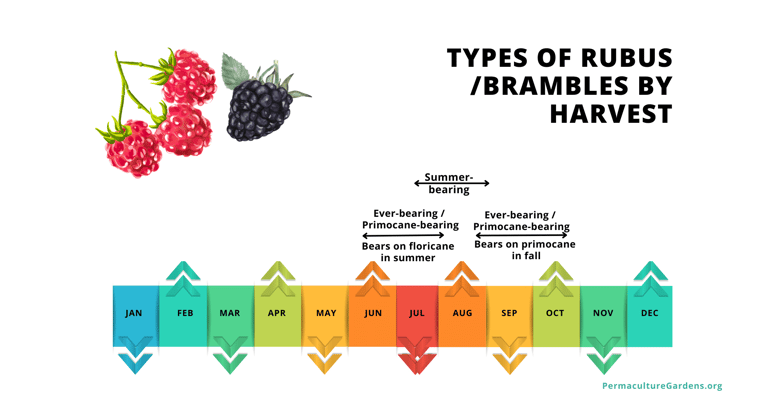



Blackberry (Rubus subg. Rubus)
There are so many health benefits to eating blackberries in particular, that it would be a shame to miss out on growing these fruits in your perennial garden.


How to Choose the Right Blackberry
Much research on blackberries and suggestions for regional varieties can be found on the following institution websites:
Washington State University
Mississippi (heat tolerant variety: Dormanred)
Ohio
Click on these links to learn about varieties suitable to your particular climate.
1. Select a variety that is likely to grow in your climate.
Look at some of the breeding programs below and select one from a climate close to yours.
2. Choose a variety that has been bred for traits that you desire: productivity, thornlessness, taste, disease resistance, etc.
Perhaps ask the question, does taste override ease of harvest?
One of the diseases that affect blackberries is Botrytis cinerea or "fruit rot." See if you can find varieties in your area that are resistant to this rot.
3. If your location has options, choose a variety that will yield for a longer amount of time. There are Summer-bearing varieties, and Ever-bearing varieties (that yield twice a year, instead of just in the summer).
4. Decide what level of thornyness you are willing to tolerate. Some varieties are bred to be "thornless" which does not necessarily mean there are no thorns on the plant, only that there are fewer. Does taste trump ease of cultivation and harvesting? These are questions to note before purchasing.
Regional varieties for blackberry
Where to purchase blackberries
Cornell University has an extensive list of blackberry varieties (organized based on fruiting season) and the nurseries that sell them.
Here are our favorite resources for raspberries:
Burnt Ridge Nursery (Washington)
One Gree World (Portland)
Raintree Nursery (Washington)
Blackberries are categorized according to their growth habit:
Trailing - planted about 3-4 feet apart and tend to send out long canes and laterals. Usually thorny, though some varieties such as "Wild Treasure" have been bred to be thornless.
Semi-trailing - not as prone to ramble as the trailing, kind, these types need to be trellised and are some of the most productive varieties. They are also called, "semi-erect"
Erect - these varieties are the easiest to trellis and with design, can develop, a very strong "leader" cane that you can train against a fence or a wall.
Types of Blackberry

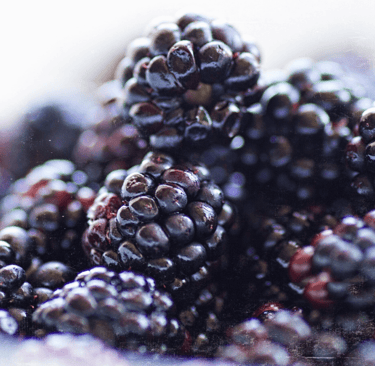
Blueberries (Vaccinium sect. Cyanococcus)
Blueberries are native to North America, and the United States is the largest commercial source of blueberries worldwide.
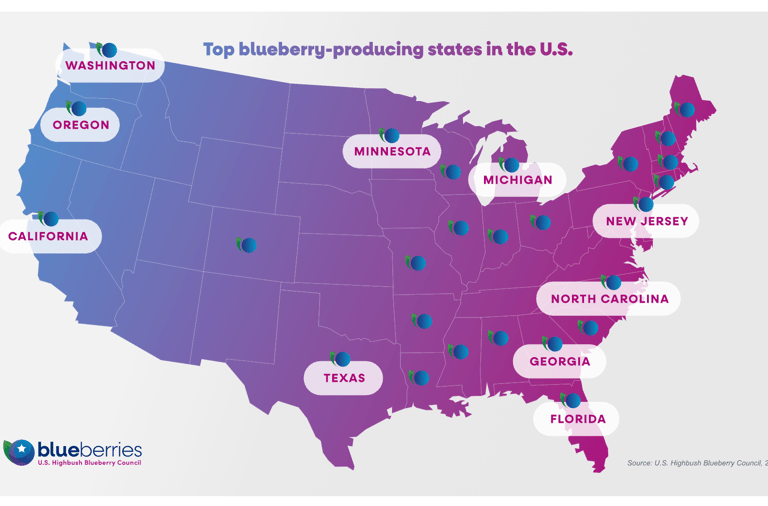

Where do Blueberries Grow?
According to the US Highbush Blueberry Council," the highbush blueberries we enjoy here in the U.S. grow and thrive across the nation, as well as in Canada, Mexico, South America, and around the world."
But there are new varieties of blueberry being developed every year that are now bred to be more heat-tolerant, or less acidic
Blueberry Requirements
Aside from needing a lot of sun, blueberries also require a lot of moisture, so it’s best to heavily mulch with something like peat moss or pine mulch (for the acidity) or grow alongside a groundcover like strawberries or yarrow to establish.
All blueberries and their derivatives are from the Ericacea or Heath family (which also includes Hydrangeas, Rhododendrons, Mountain Laurels, and Cranberries).
As such, they have good fungal associations with Ericoid mycorrhizae. If you don't already have these in your garden (or in the pot in which your blueberry is grown) please add this to the soil. This good fungus supports your ericaceous plants’ growth.
Blueberry Disease
One major blueberry nemesis is "Mummy Berry" disease. If you are choosing varieties, look for those that may be less susceptible to this if not resistant.
The image below shows a survey of certain blueberry varieties and their resistance to this fungal-borne disease.
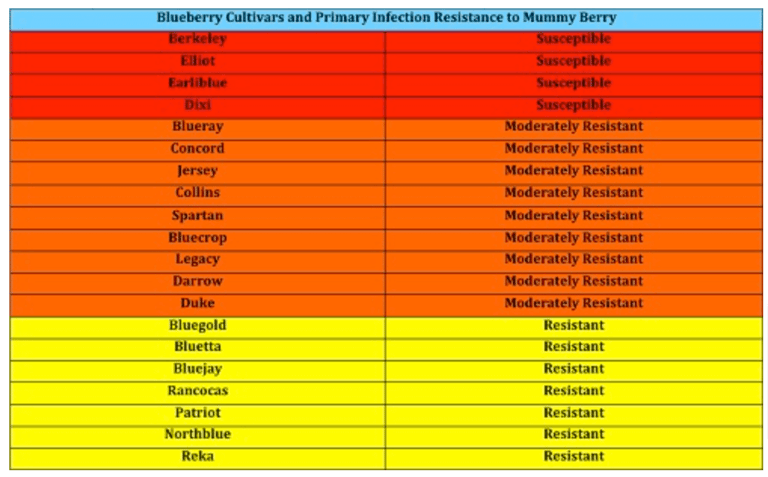

Courtesy of the American Phytopathological Society
A bush-like canning plant, highbush blueberries will produce clusters of small green berries that ripen and fatten into bluish-green berries.
Blueberries require acidic soil to flourish and a minimum number of chill hours to produce fruit. An established blueberry bush can last up to 20 years. Skyview Lab Blueberry Farm in Pennsylvania has blueberry plants over 50 years old!
Northern Highbush
Northern Highbush blueberries grow best in the Northern United States and Canada. These varieties are cold-hardy and have a 1000-hour "Chill Requirement."
"Chill Hours" means the plant has to go through six weeks of 32-45 F or 0-7 C temperatures to fruit after winter.
Where to grow: Canada, Northern United States, Eastcoast
pH Requirement: 4.5-5
Chill Hours: 1000 (6 weeks)
Where to Buy Northern Highbush Blueberry Plants:
Downside: Must be pruned regularly
Southern Highbush
These plants have similar growth habits to that of northern highbush blueberries but are adapted to mild weather such as those in the southern United States.
Where to grow:
Coastal Georgia
Florida
Tenessee
Kentucky
Virginia
North Carolina
California and the central Mexican highlands.
pH Requirement: 4.5-5.5 (a little higher than Northern Highbush)
Chill Hours: 0 to 400 hours (none to two weeks)
Downside: Must be pruned regularly
Where to Buy Southern Highbush Blueberry Plants:
Highbush Blueberry Varieties (Vaccinium corymbosum L.)
Lowbush blueberries grow low to the ground in a sprawling kind of way. These varieties are sometimes called "wild" blueberries in Maine and other parts of New England.
Since the fruits from these plants are small and low to the ground, they are a lot of fun for kids to harvest! They have an intense flavor making them perfect to incorporate in baking, pastries, and many processed products.
Where to grow: Maine & New England, Northern Eastcost
pH Requirement: 4.2-5.5
Chill Hours: 500-550 (3 weeks)
Where to Purchase Lowbush Blueberries:
Downside: Not self-fertile. Needs to cross with Lowbush or Highbush varieties of similar bloom times.
Lowbush Blueberry Varieties (Vaccinium angustifolium Aiton)
Rabbiteye blueberries are best suited for the Southeast and the Southern Hemisphere. They are derived from a Southeastern United States variety of blueberries called V. ashei. and have adapted to grow in the heat and drought with limited organic matter.
Rabbiteyes form crowns with suckering stems 6.5 feet (2 meters) tall. Their fruits have thicker or firmer skin than the northern highbush blueberry.
Where to grow:
Georgia
Florida
Mississippi
California
pH Requirement: 6.5 and lower
Cold Tolerance: -10F (-23C)
Chill Hours: 300-700 (1.5 to four weeks depending on variety)
Where to Purchase:
Downside: Early rabbiteye blueberries ripen four weeks later than southern highbush varieties and are more disease-prone (blueberry rust) than other blueberries.
Rabbiteye Blueberry Varieties (Vaccinium virgatum)
According to the USDA, "These hybrids were developed in northern climates, such as Minnesota, where plant stature was designed to be lower than the snow level in winter. The snow being an insulator could protect the dormant buds of blueberry plants from the drying winds and minimum temperatures of winter."
Because Half-high blueberries are "dwarf" varieties, they are great options for container growing. They are also less likely to suffer from winter damage than highbush types.
Where to Grow: Minnesota, Iowa, Vermont, Pacific Northwest
pH Requirement: 4.5-5.5
Cold Tolerance: -35F (-37C)
Chill Hours: 800-1000 (four to six weeks)
Where to Purchase:
Half-High Blueberry Varieties (Vaccinium angustifolium-corymbosum hybrid)
Cranberries are red tart berries grown from cuttings cultivated commercially bogs. However, who says you need a bog to grow cranberries?
This beloved addition to Thanksgiving tables across America can also be grown at home.
See the cute video below.
Other Vacciniums to Consider Growing
Cranberries (Vaccinium macrocarpon) - in the Americas
(Vaccinium oxycoccos) - in Europe

Where to Buy Cranberry Plants:
Lingonberries - are red berries originally from Scandinavia that are popular in jams and conserves. They can also be grown in a backyard garden
Below is a video from Darcy at Farm Food Feast. Darcy grows lingonberries in his backyard in Ontario. He says that for a climate that does not have options for growing lemons and limes, lingonberries add that acidic tartness to pies and baked goods that lemons and limes provide in warmer climates.
Lingonbery (Vaccinium vitis idaea)

Where to Buy Lingonberry Plants:
Aronia (Aronia melanocarpa, Rosacea family)
A native North American alternative to blueberry is the aronia berry, also called "chokeberry." Of the three main varieties: the black the red and a hybrid of the two, the black is the most common.
You want to eat aronia berries because they are a valuable source of antioxidant compounds that decrease oxidative stress and inflammation and regulate cholesterol, and blood pressure.
Their growth habit is similar to blueberries but it has far fewer diseases and pests due to the chokeberries being more acidic. It is also a fantastic plant for supporting local wildlife.
Where to Grow: USDA Zones 3-8 (Native to Eastern US)
pH Requirement: 6.3-6.8
Cold Tolerance: -22F (-30C)
Heat Tolerance: 95F (35C)
Chill Hours: 800 (4-5 weeks)
Where to Purchase:
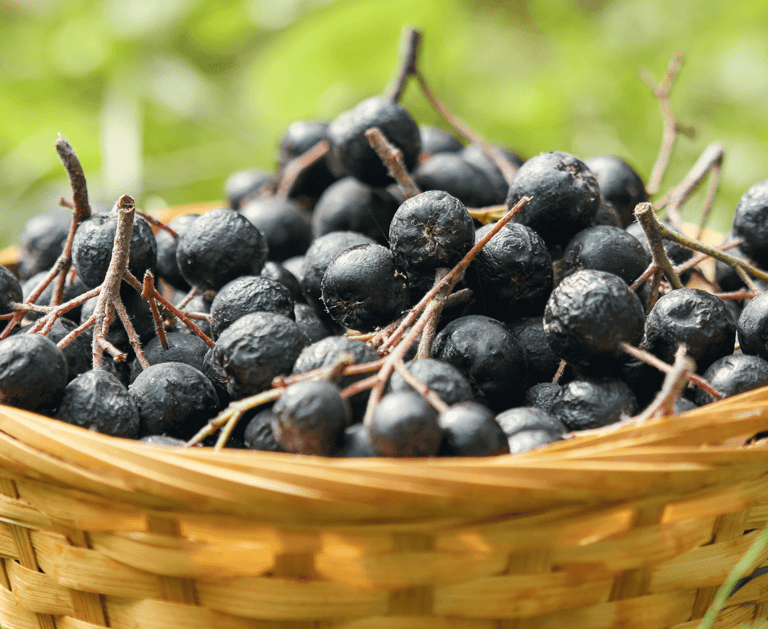

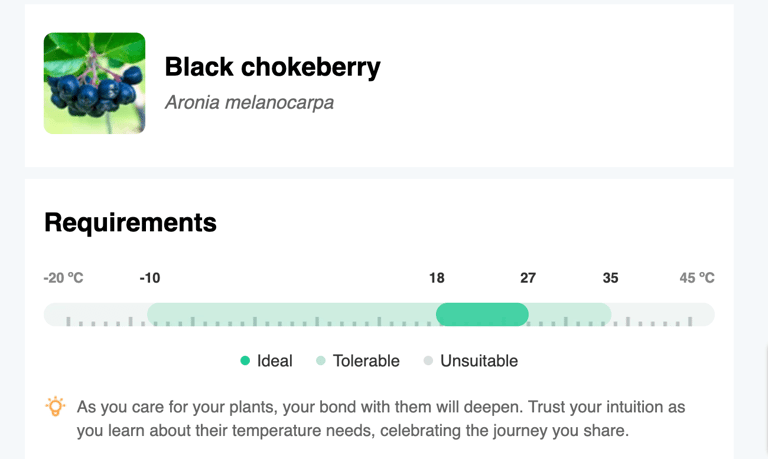

Courtesy of Picture This AI
Goji Berry (Lycium barbarum, Solanacea family)
Also known as "Wolf-berry" in China, Goji berries are one of the latest nutritional fads since they are known to protect against cancer and create immune system support. Dried goji berries in stores cost $10-$20 per pound.
Goji berry is a thorny caning plant that produces huge long canes (up to 12ft. long) covered with dense green growth. Small purple/bluish flowers will sprout along the cane and turn into small elongated red berries.
Goji tends to take a few years to establish and fruit. After it is established, it tends to take over, so make sure to aggressively prune cross branches and train existing canes in an orderly way.
Where to Grow: Zones 4-9 (but not where temperatures rise over 85F / 29C as fruits will not set)
pH Requirement: 6.8-8.1
Cold Tolerance: -18F (-27C)
Heat Tolerance: Flowers do not set fruit over 85F /29C
Chill Hours: None
Where to Purchase:

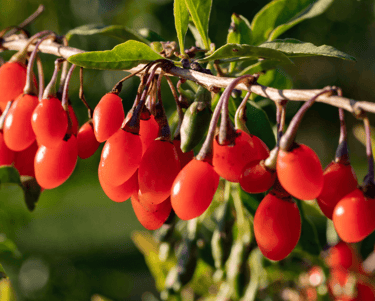
Gooseberry/Currant (Ribes)
Gooseberries (Ribes uva-crispa) and currants (Ribes) are cultivars from the family Grossulariaceae.
Very popular in Europe, gooseberries and currants are small round berries growing on thorny, caning-style bushes.
The berries are traditionally green with a pleasant tart flavor, but recent hybrids have produced sweeter red versions.
Currants are very similar to gooseberries, although they tend to be a bit smaller and a bit more tart. Currants can also range in color from white through red to black.
Gooseberries were restricted for a long time in the U.S. because of their ability to be a carrier of white pine blister rust, which doesn’t affect them but does affect commercial pine plantings, so it’s best to check in your state whether there are still restrictions on them.
Similarly, currants also have state restrictions for particular varieties of currants. The links below will let you know if they can or cannot ship a specific berry to you.
An easy plant to take care of (just requiring regular pruning to promote an open branch structure for maximum production), gooseberries and currants are lesser-known berries that are worth growing in many people’s backyards.
Where to Grow: Zones 3-8 Northeastern United States and Pacific Northwest
pH Requirement: 6.8-8.1
Cold Tolerance: -40F (-40C)
Heat Tolerance: Flowers do not set fruit over 90F / 32C
Chill Hours: 800-1000 (six weeks)
Where to Purchase:
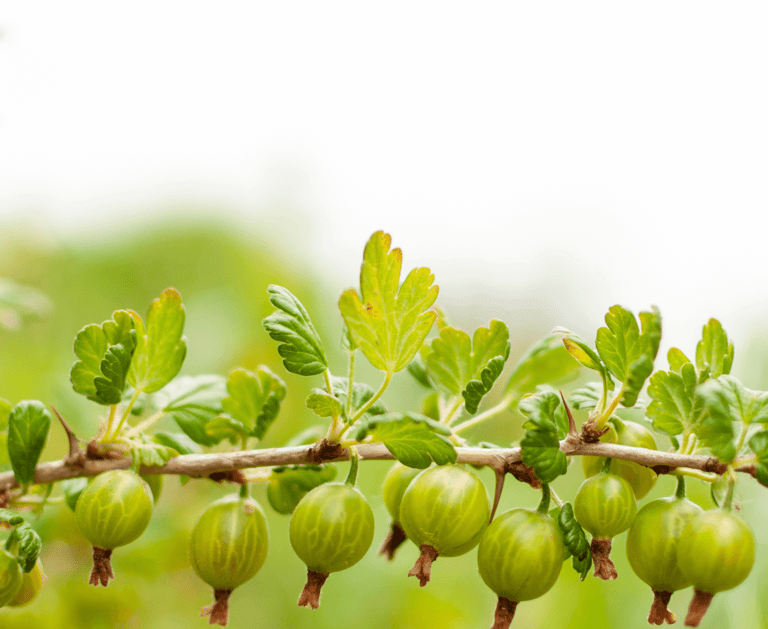

Goumi (Elaeagnus multiflora) /
Autumn Olive (Elaeagnus umbellata)
Goumi berries or Autumn Olive plants are interesting shrubs because they fix nitrogen while providing tasty berries. (Goumi berries taste much better than autumn olives, though.)
Goumi is one of the few non-leguminous plants that fix nitrogen, working in symbiosis with Frankia bacteria in its root system. Goumi are fast-growing and can produce up to 30lb / 13 kilos of fruit per bush. The berries are elongated, red berries with a single seed that easily drops off the bush when fully ripe.
Eleaganus prefer partial shade and can be grown in coastal weather.
Where to Grow: USDA Zones 4-9 (Eleaganus umbellata) USDA Zones 5-9 (Eleaganus multiflora)
pH Requirement: 6 to 7
Cold Tolerance: -4F (-20C)
Heat Tolerance: Flexible within
Chill Hours: 800-1000 (six weeks)
Where to Purchase:
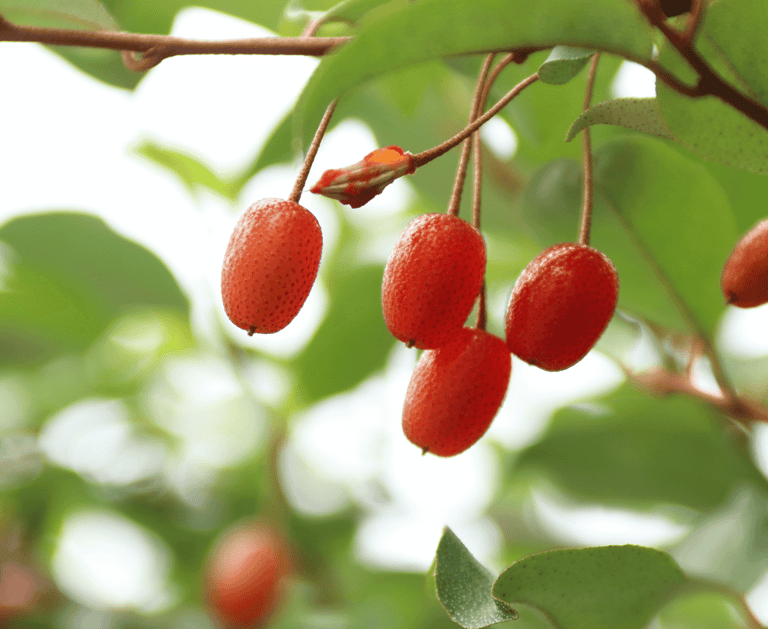

Sea Buckthorn (Hippophaë rhamnoides L., family Eleagnacea)
Another berry that has caught recent attention for its very high antioxidants, sea buckthorn, also known as "seaberry," is a hardy tree-like shrub that grows in Northern and Eastern Europe and widespread in Asia. The Seaberry is cultivated for its juice with is high in Vitamin C and considered medicinal. This plant produces tart, bright-orange berries. Sea buckthorn berries are typically sweetened and processed for juice.
Sea buckthorn is considered invasive in some places and is extremely vigorous as it is another nitrogen-fixing plant like its relations to the Goumi berry and Autumn Olive. However, it prefers full sun to reach full production and is drought-tolerant.
Trees are male or female, so a male pollinator tree is required to provide pollination for up to eight surrounding female trees.
Where to Grow: USDA Zones 3-9 (possibly 10)
pH Requirement: 5.5 to 8
Cold Tolerance: -40F (-40C)
Heat Tolerance: up to 105F (40.5C) but set better fruit up to 90F (32.3C)
Chill Hours: None
Where to Purchase:
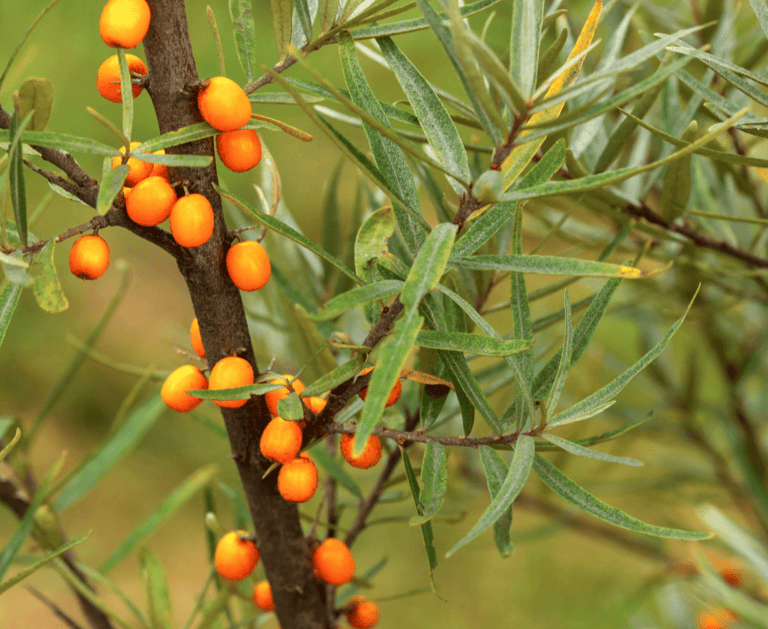

Elderberry (Sambucus nigra)
Elderberry syrup is a home remedy used by herbalists from the European tradition to reduce symptoms of viral infections such as the flu.
This shade-loving plant produces dense umbrella-like clusters of small white flowers that become blackberries. Elderberries can grow up to 12 feet tall and need quite a lot of pruning if grown in a small space. Their root system is known to encourage soil microbial activity, so they are quite often planted near compost bins.
Elderberries are poisonous when consumed raw, but steeping your berries in boiled water for 10 minutes (as in tea) removes their toxicity.
Where to Grow: USDA Zones 4-9 (Eleaganus umbellata) USDA Zones 5-9 (Eleaganus multiflora)
pH Requirement: 6 to 7
Cold Tolerance: -4F (-20C)
Heat Tolerance: Flexible within
Chill Hours: 800-1000 (six weeks)
Where to Purchase:
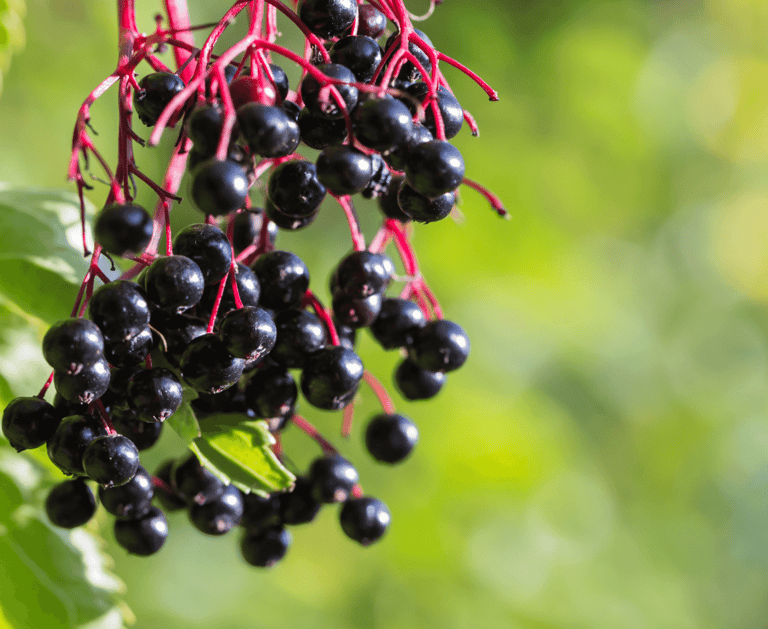

Mulberry (Morus)
Like other berries, mulberry fruits are high in antioxidants, Vitamin C, and flavonoids, so we include them for your consideration.
The three most popular species of mulberries that are grown in Europe North America and Asia are the red, white, and black mulberry.
Red mulberries. are native to the United States and can grow up to 70 feet (21 meters) tall.
The white mulberry (most preferred by silkworms) is more heat-tolerant and as its name suggests grows large white fruits. It is native. to Northern, Eastern, and Central Asia.
Black mulberries are considered "superior in flavor," and are native to Southwest Asia.
A curious thing about mulberries in the US is that they are banned in Arizona due to the fact mulberry pollen induces allergies. However, only the male mulberries produce the pollen, and fruit-bearing females do not.
There are desert varieties and shade varieties of mulberries.
Make sure to select the varieties that are suitable for your climate.
Where to Grow: USDA Zones 4-10
pH Requirement: 5.5-7
Cold Tolerance: -25F (-31C)
Heat Tolerance: 95F (35C) but optimal fruit production at around 75F (23C)
Chill Hours: 600 (4-5 weeks)
Where to Purchase:
The Essential Guide to Mulberries
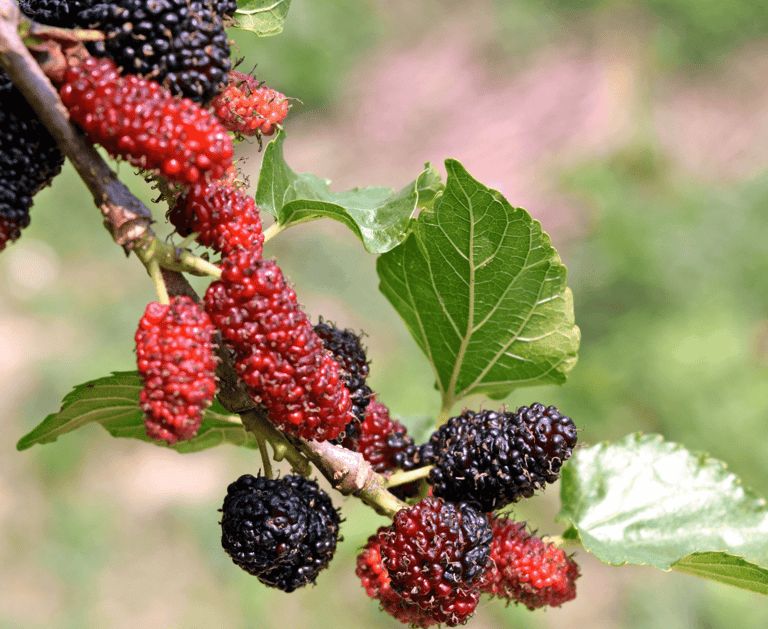

‘Of all the cultivated trees, the Mulberry is the last to bud,
which it never does until the cold weather is past,
and it is therefore called the wisest of trees.
But when it begins to put forth buds, it dispatches the business in one night and that with so much force that their breaking forth may be clearly heard."
Pliny
Honeyberry (Lonicera caerulea)
Dubbed the "blueberry of the prairie," this honeysuckle relative produces sweet large, elongated blueberries.
Honeyberries are relatively new to the berry-growers market and originate from Russia and Japan. The varieties are usually available for purchase in the spring.
Honeyberries have even higher levels of antioxidants than blueberries with twice the Vitamin A and four times the Vitamin C.
Another benefit is that these plants are cold-tolerant, have few pests, and can withstand a wide pH range in soils.
Where to Grow: USDA Zones 2-7
pH Requirement 3.9-7.7 but best in 5.5 -6.5.
Cold Tolerance: -55F (-48C)
Heat Tolerance: 85F (30C)
Chill Hours: 1000-1200 (6-7 weeks)
Where to Purchase:
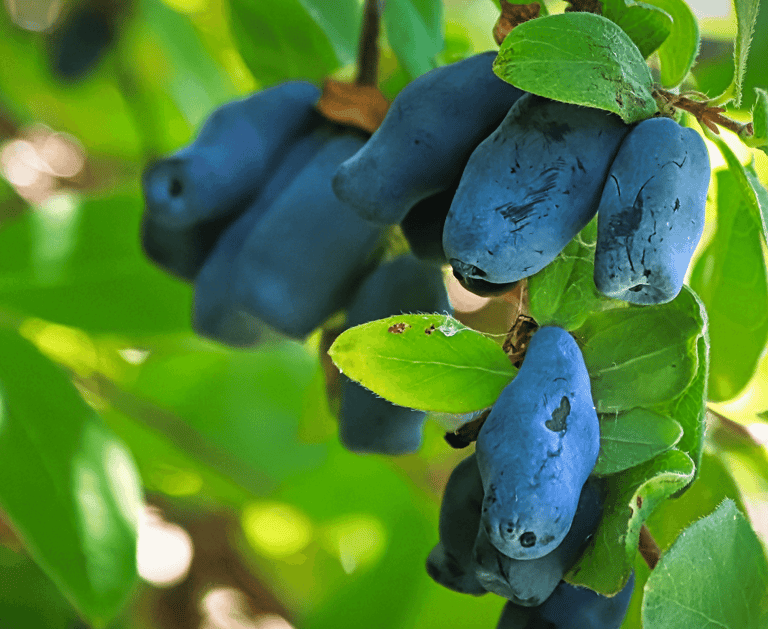

Juneberry / Shadbush (Amelanchier)
Amelanchier goes by many names including Shadbush, Juneberry, Saskatoon berry, and Serviceberry. Its edible berries are eaten raw or in pies, muffins, wine, and jams.
It is native to the Northern United States (upper midwest northern prairie region of Canada) and there is currently no commercial production (as of this writing) of this fruit. Despite this, they grow
Juneberries or Serviceberries are similar nutritionally to blueberries, They produce blueberry look-alikes from as their name suggests, in June. We have an example of how. to incorporate Amelenchier into your backyard in this shade garden blog.
There are two main varieties available to growers in North America and those are the Amelanchier canadensis and the Amelanchier alnifola. You will see an option for purchasing wild Amelanchier below as well.
Where to Grow: USDA Zones 4-7
pH Requirement 6.1-6.5
Cold Tolerance: -40F (-40C)
Heat Tolerance: 90F (32C)
Chill Hours: 1000 (6 weeks)
Where to Purchase:

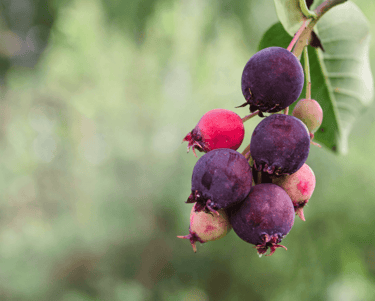
Grapes (Vitis vinifera, Vitis lambrusca or Vitis rotundifolia)
It is fitting to end this lengthy blog on a high note. Let us not forget that we can all plant grapes.
Grapes have been cultivated for over 8000 years.
North America can trace its grape history to the town of Concord, Massachusetts where seeds from the wild Vitis labrusca were first cultivated.
There are three major types of grapes cultivated in the US.
Vitis labrusca - (USDA zones 4-7) best thrives in the Northeast United States. These often table grapes, juices, and jellies.
Vitis vinifera - grapes that were cultivated mostly in Europe (zones 7-10) and need a longer growing season.
Vitis rotundifolia - Muscadine grapes that are native to the Southeastern and South Central United States. They are acclimated to growing well in the humid South (zones 7-9) and have smoother bark than vinifera varieties.
Some of the most extensive research on grapes can be found at the University of California, Davis.
UC Davis hosts a directory of 567 varieties (and sub-classes) of grapes for wine, juice, table, raisin, and rootstock growing purposes.
Figure out what grapes you would enjoy and which kinds are suitable for your climate below.
Where to Grow: USDA Zones 4-10
pH Requirement 5.5-6 (Vitis lambrusca) 6.5-8 (Vitis vinifera and others) according to this extension agency
Cold Tolerance: -25F (-31C)
Heat Tolerance: 100F (37C)
Chill Hours: 50-400 (2 days to 3 weeks)
Where to Purchase Grapes:
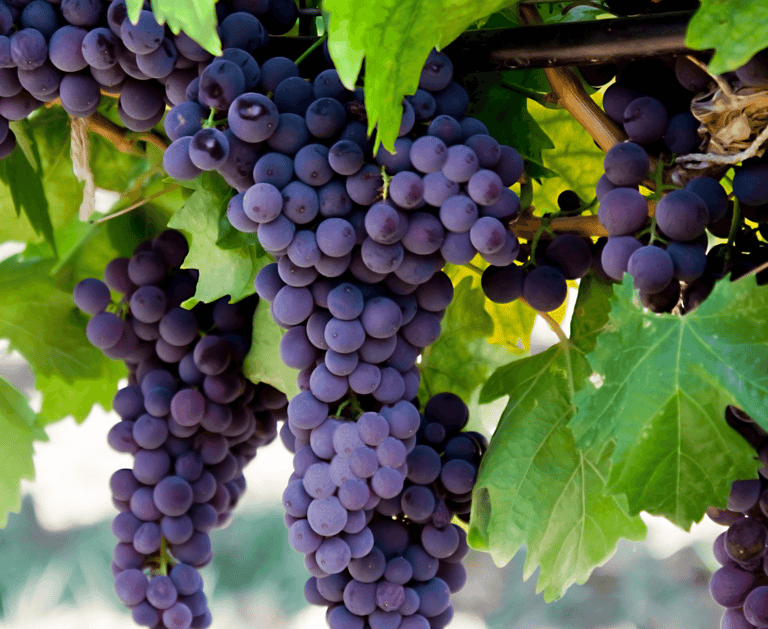

The merry year is born
Like the bright berry from the naked thorn.
HARTLEY COLERIDGE
How to Choose Your Berry
3. Choosing Which Berries to Grow
Now that you've had a tour of at least twelve types of berries to consider, how do you choose which one is right for you?
Choose the berries that grow well in your climate
There are berries everywhere. And so much research has been done in the past 20 years alone to breed varieties that acclimated to the north or south and in between. Use the resources in this blog as a springboard to discovering the berry that can grow perfectly well where you live.
Choose the berries you want to eat
Some berries are fun to grow, but then a waste when no one in the house wants to eat them. Make sure that you grow something you like to eat.
Choose your berry plant according to its function
In permaculture, we talk about “stacking functions” in one element: One plant can serve several purposes. Berries are multi-functional plants. They are practically brimming over with functions! The ones featured here all serve as food, some as medicine. Some of these berries fix nitrogen for the plants around them to grow well. Some are native habitats to support the wildlife in your backyard. Choose a berry that gives you joy and choose one that feeds you in more ways than one.
Choose your berry plant according to its physical growth habit
Because of their different growing characteristics, you not only stack functions but can even physically stack various berry plants in the same space.
For example, grow a thorny gooseberry beside strawberries to protect strawberries from deer-browsing. As an understory, strawberries provide a ground cover to protect the gooseberry roots. The understory is one of several layers we discuss when building permaculture guilds.
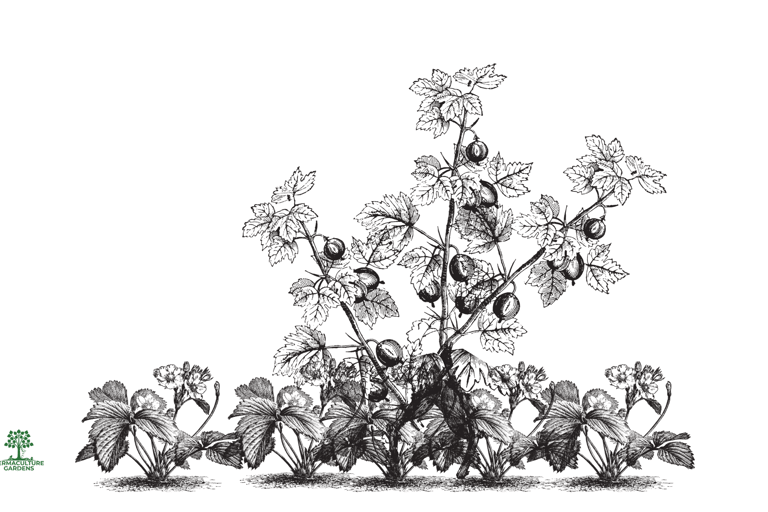

There are many diverse options for berry combinations and we highly recommend growing many different types in your garden.
I’ve discovered that berries are pretty good at figuring out their niche in your growing landscape and with a bit of design about the preferred growing environment can be seamlessly integrated next to your annual crops.
Choose your berry according to the length of harvest
When choosing which berries to grow, remember that you aim to feed yourself and your family from your garden for as long as you can. Therefore, be governed by the seasonality of berries. Choose varieties that ripen at different times of the year and not all at once. Choose varieties with longer growing seasons.
Here's a little infographic that captures the seasonality of berries in one year.
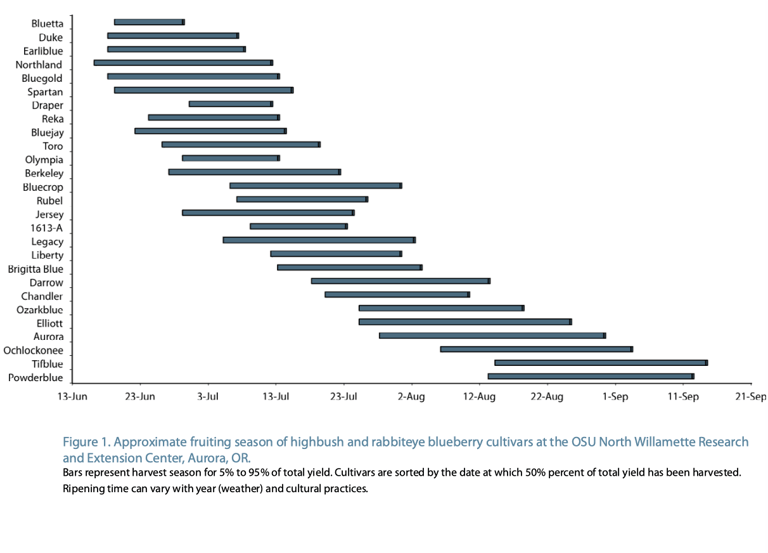

A berry combination of strawberries grown underneath gooseberries
Image courtesy of Oregon State University
Choose pest and disease-resistant varieties.
One of the leading causes of blueberry, strawberry, and cane berry crop failure in the United States was the advent of the Spotted Wing Drosophila fly in the United States. Since 2008, this particular pest has been plaguing the berry industry.
From birds to insects, knowing what your pests are beforehand can help you prepare your plant so that you can harvest as much fruit as possible. You can do this by:
Stimulating a plant’s innate immune system response
Creating physical barriers such as row covers to protect from pests and
Applying targetted natural sprays such as neem oil, garlic, baking soda, and biopesticides
But if a specific variety has been bred to develop a resistance to a specific pest, it would be wise to choose varieties that have more pest or disease resistance.
Want to know which berries are bred for your specific climate check this US Plant Breeding Program Map out.
What berry does my state specialize in?
Dig Deeper
Help, my berry has Mummy Berry Disease!
The American Pathological Society has a detailed page on Mummy Berry disease which afflicts blueberries and grapes. From our current research on Compost Tea, it seems that the application of aerated compost tea can help mitigate the onset of this fungal infection.
What other plants will grow well with my berry?
What is your definition of "berry?"
Email us at permaculturegardens.org so we can include it here.
I grow a berry that's not on your list.
There are many players that can support berries as companion plants. And berries themselves can support trees. In permaculture, we call these beneficial plant groupings a "Plant Guild."
Here's a blog and video on Permaculture Guilds.
Note on Etymology:
In this article, we use the term “berry” loosely to define any small, fleshy fruit that is somewhat round, juicy, and tart or sweet rather than savory (like a tomato).
Botanically, fruits like raspberries and strawberries are not true berries but rather “aggregate fruits” that form from a single flower with many pistils, each of which develops into fruitlets.
Oddly enough, a tomato is a true berry because it is derived from one ovary of one flower.
But a blackberry is not.
Go figure.
In this blog, we are helping you find "berries" to grow in your garden. Those are fruits that are sweet
(or tart), smallish, and roundish to make into jams, and jellies or enjoy munching on raw.
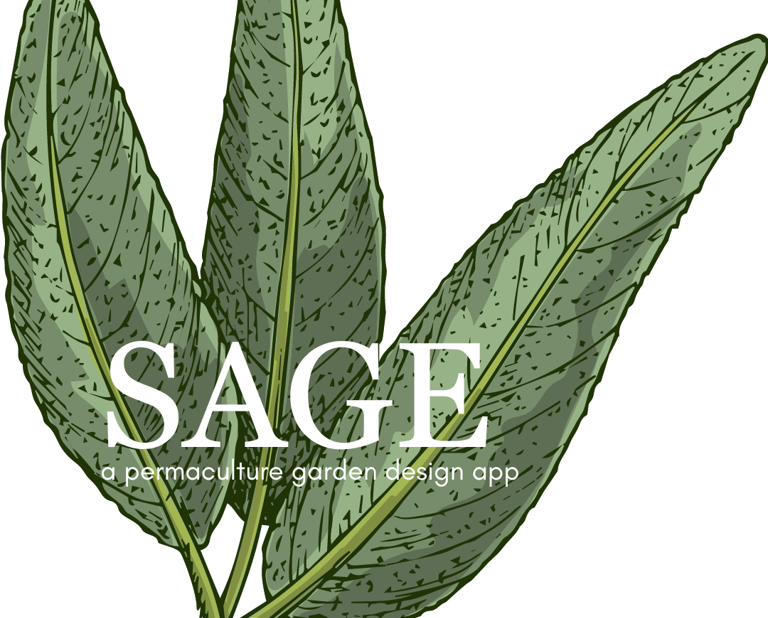

Our SAGE garden planning app allows you to plan & design your food garden so you don’t waste hours wondering what to plant and when to plant it!
Dig Deeper
"AI, build a permaculture guild around my berry bush."
We've got something better than hit-or-miss bot recommendations. We are developing an app that can help you figure out what to grow with your fig, and much more!
It's called SAGE: a permaculture garden design app.
I WANT TO GROW MORE
Sign Up for a
Permaculture Garden Course
I AM A BEGINNER
I WANT MY DREAM GARDEN
Sign up for the
Grow-It-Yourself Program
Everything you need to start a garden
may be hidden in your pantry.
Take a self-paced, step-by-step garden course to help you grow right from seed to harvest.
Make Your Organic Food Garden A Reality with
a garden mentor
a community
an app &
a proven plan!



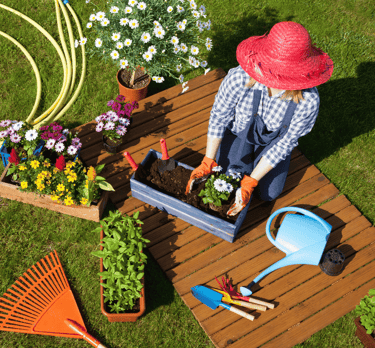


Choose one next step.
Which of the following are you?
Permaculture Gardens - your online resource for organic & sustainable gardens.
Contact
permaculturegardens@gmail.com
Bethany Farm
41558 Stumptown Rd.,
Leesburg, VA 20176

